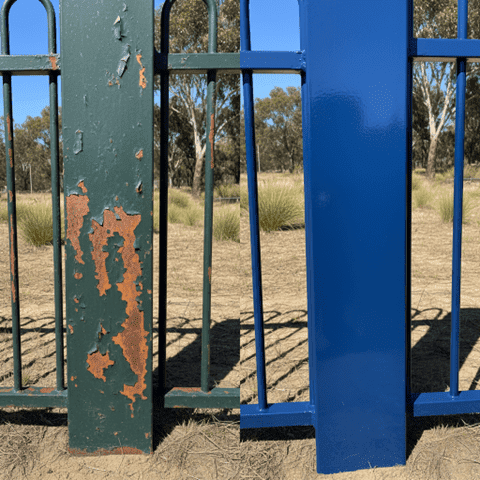Australia presents its own unique set of challenges when it comes to protecting and finishing metal surfaces. From intense UV, coastal salt air, sudden storms, to heavy industrial usage — these factors all combine to demand high-performance, long-lasting coatings. If you’re comparing powder coating vs traditional paint, here’s why powder coating often comes out ahead — especially in Aussie conditions — and how Superior Coaters leverages these advantages to deliver superior finishes.
What Is Powder Coating and How Does It Compare to Traditional Paint
Powder coating is a dry finishing process, using finely ground particles of pigment and resin. These powders are electrostatically charged and sprayed onto a grounded metal object; once coated, the item is baked in an oven to cure, forming a hard, durable finish. Traditional paint, by contrast, is liquid paint applied via brush, roller, or spray, then allowed to air dry.
The key differences between the two are:
|
Feature |
Traditional Paint |
Powder Coating |
|
Drying / Curing Process |
Air drying (or low-heat touch-ups) |
High-heat bake/melt & cure |
|
Build and Thickness |
Multiple coats needed, thinner |
Higher film thickness in one coat; more uniform covering |
|
Durability |
Less resistance to wear, chipping, fade, chemical & moisture ingress |
Superior resistance to chipping, UV, corrosion, moisture, abrasion |
|
Environmental & Health |
Often uses more solvents (VOCs), more waste |
Low/no VOC, overspray can be reclaimed, less waste |
|
Maintenance & Lifespan |
More frequent repainting, more maintenance |
Longer lifespan, less frequent maintenance needed |
Why Powder Coating Is Especially Well-Suited for Australian Conditions
- UV Stability & Colour Fade Resistance
The Australian sun is harsh. Constant UV exposure breaks down paint binders, causing fading, chalking, and loss of gloss. Powder coatings use resins that are much more stable under UV, especially when high quality pigments are used, ensuring colours stay vibrant for much longer. - Corrosion Resistance in Coastal Areas
If your project is near the coast, salt spray and humid air can cause rapid corrosion. Traditional paints can blister, crack or peel under those stresses. Powder coating, when properly applied and cured, forms a continuous, resilient barrier that resists moisture ingress much better. - Durability Against Wear, Chemicals and Impact
Industrial sites, outdoor furniture, gates and fencing, architectural fixtures — all are exposed to wear, impact, cleaning chemicals, and temperature fluctuations. Powder coating is far more chip-resistant and better able to endure mechanical stresses than many paints. - Lower Maintenance & Total Life Cost
While the initial cost of powder coating may be higher in some cases, over the long term you save. Less frequent repainting, lower touch-ups, and longer intervals between maintenance mean lower cumulative cost over the life of the item. - Environmental Considerations
Using fewer solvents (lower VOCs), reclaiming overspray, and producing less waste make powder coating a greener choice. For government, commercial or architectural projects, this can also help with compliance, certifications or sustainability goals.
Cases Where Traditional Paint Still Has a Place
Even though powder coating excels in many areas, there are situations where traditional paint might still be preferable:
- When very fine detailing or thin edges are involved and heat might warp or affect dimensions.
- For very large structures or field-applications where bringing on-site heat curing isn’t feasible.
- When touch-ups are frequent and small, or when matching exact colour later is more practical with liquid paint.
Superior Coaters often helps clients assess the trade-offs and choose the right system for each project.
How Superior Coaters Ensures You Get the Full Benefit
At Superior Coaters, with over 35 years of surface finishing experience in Queensland, we’ve honed our process to maximise the advantages of powder coating for Australian environments. Here’s what sets us apart:
- A modern bake oven system capable of consistently curing large pieces, ensuring uniform finish and strength.
- Quality control across every phase — from metal prep and cleaning to surface profile, correct masking, and final curing.
- Using premium powders suited to harsh environments (UV-stable, corrosion resisting, abrasion and chemical resistant).
- Capability to handle oversized and complex architectural or industrial structures. (See how we manage large-scale objects in Behind the Scenes: How We Powder Coat Oversized Structures Up to 14 Metres). [link]
- Consulting with clients on long term costs, paint vs coating options, maintenance schedules etc.
Linking to Related Articles
To dive in further and see how these principles translate into practice, check out the following posts from our blog:
- Why Powder Coating is the Superior Choice for Industrial Durability — discusses how powder coating makes a difference under heavy use.
- How to Match Industrial Needs with Powder-Coating Performance — helps you align coating systems with the actual usage.
- 5 Ways to Ensure Your Powder Coating Project Turns Out Perfect — great practical tips to avoid common defects.
- 5 Common Coating Mistakes Businesses Make – And How to Avoid Them — learn about pitfalls in coatings and how to prevent them.
- Colour Trends & Custom Finishes: Inspiring Ideas for Architectural Projects — see how aesthetic goals are met while not compromising durability.
Conclusion
In the balance of performance, lifespan, appearance, maintenance cost, and environmental impact, powder coating generally outperforms traditional paint — particularly in Australia, where UV, salty air, heat, and industrial wear are big factors.
If you’re planning a fencing or architectural project, industrial machinery, or outdoor installations, taking time to evaluate coating systems with powder coating in mind could pay off significantly in the long run.
Want help choosing the right finish or assessing whether powder coating is right for your next project? Reach out to us at Superior Coaters — our experience in Brisbane & Queensland gives us insight into what works best for local conditions.

 07 3375 6777
07 3375 6777